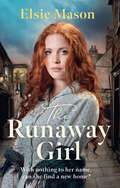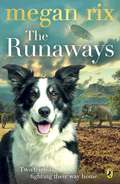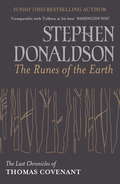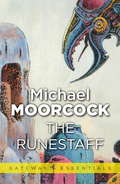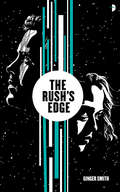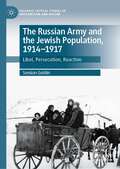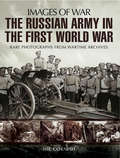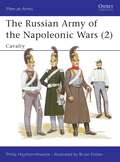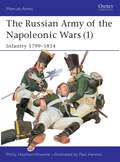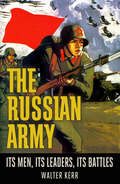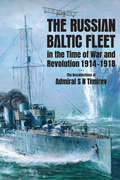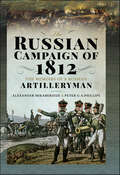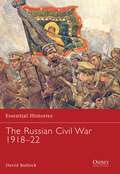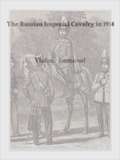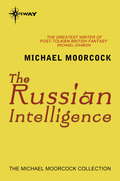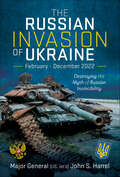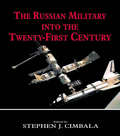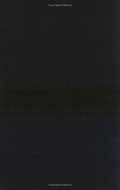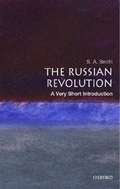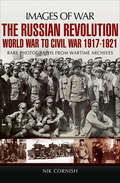- Table View
- List View
The Runaway Girl (Sixteen Streets Trilogy)
by Elsie Mason1918. Fleeing from her past, Cathy Carmichael is new to the Sixteen Streets. She has nothing to her name, no plan and nowhere to go.Cathy thinks she's struck gold when she runs into Mrs Sturrocks, an elderly lady who offers her a room at her boarding house. Her son, Noel, might be strange and sulky, but he gives her a job at the Robin Hood pub and before long, Cathy is thriving as the new barmaid. The Sixteen Streets was only meant to be a temporary stop for Cathy... but could it become home instead?
The Runaway Girl (Sixteen Streets Trilogy)
by Elsie Mason1918. Fleeing from her past, Cathy Carmichael is new to the Sixteen Streets. She has nothing to her name, no plan and nowhere to go.Cathy thinks she's struck gold when she runs into Mrs Sturrocks, an elderly lady who offers her a room at her boarding house. Her son, Noel, might be strange and sulky, but he gives her a job at the Robin Hood pub and before long, Cathy is thriving as the new barmaid. The Sixteen Streets was only meant to be a temporary stop for Cathy... but could it become home instead?
The Runaways
by Megan Rix*2015 RED HOUSE CHILDREN'S BOOK AWARD SHORTLISTED AUTHOR*A brand new animal adventure for 8+ readers set during World War One from classic-in-the-making and bestselling author, Megan Rix. Perfect for fans of Michael Morpurgo and Sarah Lean.Two friends, fighting their way home . . . SHANTI and her calf TARA are beautiful circus elephants. HARVEY is the faithful old collie who leads the show.In war they will perform their most death-defying trick yet.When the First World War seizes Europe, Cullen's Circus is forced to close. The men are sent to fight and the animals are torn apart from their keepers, and each other. But while Shanti must help on a farm, it's little Tara who faces a far worse fate. . . Separated too soon from her mother, Tara's life is in danger. Only old, brave Harvey can bring them back together. And so side-by-side, dog and elephant set out on an extraordinary journey across the English countryside - but can the unlikely friends find Shanti in time?Praise for Megan Rix:'If you love Michael Morpurgo, you will enjoy this' Sunday Express'A moving tale told with warmth, kindliness and lashings of good sense that lovers of Dick King-Smith will especially appreciate' The Times 'Every now and then a writer comes along with a unique way of storytelling. Meet Megan Rix . . . her novels are deeply moving and will strike a chord with animal lovers.' LoveReading'A perfect story for animal lovers and lovers of adventure stories' Travelling Book CompanyAlso available by Megan Rix:The Great Escape, The Victory Dogs, The Bomber Dog, A Soldier's Friend and The Hero Pup
The Runes Of The Earth: The Last Chronicles of Thomas Covenant
by Stephen DonaldsonThe return of Thomas Covenant the Unbeliever!In 1977, with the publication of THE CHRONICLES OF THOMAS COVENANT THE UNBELIEVER, Stephen Donaldson created a true phenomenon: an epic fantasy instant bestseller that has now sold millions and millions of copies across the world.Thomas Covenant is mysteriously struck down by a disease believed eradicated; abandoned by his wife and young son, he becomes a pariah. Alone, despairing, Covenant falls - and is drawn into a mysterious new world where gentle people work magic and the earth itself brings healing. He is welcomed as the reincarnation of a legendary saviour, but Covenant is convinced he's having delusions. At the end of the sixth book, as Covenant battles to save the world, he is killed - in both worlds - as Dr Linden Avery, his horrified companion, looks on.Now comes the book every fantasy reader has been waiting for. It's ten years later and Linden Avery thought she would never see the Land, or Covenant, her beloved, again. But Lord Foul has stolen her adopted son, and is unmaking the very laws of nature.And though she believes Covenant dead, he keeps sending Linden messages: 'Find me', 'You're the only one who can do this' and 'Remember that I'm dead'. The Land is in turmoil, and Lord Foul has plans for them all ...
The Runes Of The Earth: The Last Chronicles of Thomas Covenant
by Stephen DonaldsonIn 1977, with the publication of THE CHRONICLES OF THOMAS COVENANT THE UNBELIEVER, Stephen Donaldson created a true phenomenon: an epic fantasy instant bestseller that has now sold millions and millions of copies across the world.Thomas Covenant is mysteriously struck down by a disease believed eradicated; abandoned by his wife and young son, he becomes a pariah. Alone, despairing, Covenant falls - and is drawn into a mysterious new world where gentle people work magic and the earth itself brings healing. He is welcomed as the reincarnation of a legendary saviour, but Covenant is convinced he's having delusions. At the end of the sixth book, as Covenant battles to save the world, he is killed - in both worlds - as Dr Linden Avery, his horrified companion, looks on.Now comes the book every fantasy reader has been waiting for. Its ten years later and Linden Avery thought she would never see the Land, or Covenant, her beloved, again. But Lord Foul has stolen her adopted son and is unmaking the very laws of nature.And though she believes Covenant dead, he keeps sending Linden messages: 'Find me’. The Land is in turmoil and Lord Foul has plans for them all…(p) 2005 Orion Publishing Group
The Runestaff: The Runestaff (Gateway Essentials #450)
by Michael MoorcockThe Dark Empire of Granbretan has humiliated and mutilated Dorian Hawkmoon, but it cannot rob him of his two consuming passions: his love for Yisselda of Brass and his hatred of her ruthless suitor Meliadus.But before he can defy the Dark Empire and win the beauteous Yisselda, he must seek the Runestaff, a quest that will send him into barbaric wonder and perverse evil ... and only if he succeeds will he avert the doom of all the world...
The Rush's Edge
by Ginger SmithWith the help of his commanding officer, a genetically engineered ex-soldier fights back against the government that created him and others like him to be expendable slaves...Halvor Cullen, a genetically-engineered and technology implanted ex-soldier, doesn't see himself as a hero. After getting out of the service, all he's interested in is chasing the adrenaline rush his body was designed to crave. Hal knows he won't live long anyway; vat soldiers like him are designed to die early or will be burnt out from relentlessly seeking the rush. His best friend and former CO, Tyce, is determined not to let that happen and distracts him by work salvaging crashed ships in the Edge.Then Hal's ship gets a new crewmember - a hacker-turned-tecker named Vivi. As they become friends, Hal wonders if he's got a chance with a natural-born like her. Then on a job, the crew finds a sphere that downloads an alien presence into their ship... Multiple clashes with the military force Hal and his crew to choose sides. The battle they fight will determine the fate of vats and natural-borns throughout the galaxy. Will they join the movement against the Coalition? What has invaded their ship's computer? And can there be a real future for a vat with an expiration date?File Under: Science Fiction [ Toy Soldier | On the Brink | Against the Odds | Stars are Crossed ]
The Russia-Ukraine War and its Origins: From the Maidan to the Ukraine War (Rethinking Political Violence)
by Ivan KatchanovskiThis open access book examines the Russia-Ukraine war and its origins. Based on analysis of a large number of primary and secondary sources, it provides a systematic analysis of this crucial war, its nature, outcome, possibility of peaceful settlement, violence against civilians, and origins. The book examines the role of such factors as the NATO accession of Ukraine, Russian imperialism, democracy, genocide, and the far-right in the start of the war and traces the conflict escalation ladder, which culminated in this war, to preceding violent conflicts in Ukraine, in particular, the Euromaidan, the Maidan massacre, the Russian annexation of Crimea, and the war in Donbas. The Russia-Ukraine war is the most significant armed conflict of the 21st century in the entire world and in Europe since World War Two in terms of countries involved, casualties inflicted, and actual and potential impact in the world. This book analyzes the involvement of different conflict parties, such as the Ukrainian, Russian, and Western governments, Donbas separatists, and the far right, in this crucial war and in the Euromaidan, the Maidan massacre, the Russian annexation of Crimea, and the war in Donbas, and the nature of these conflicts. This book also examines support for pro-Western/pro-nationalist and pro-Russian/pro-communist political parties and presidential candidates and attitudes towards separatism and joining the European Union, NATO, and the union with Russia in regions of Ukraine in parliamentary and presidential elections and surveys since the Euromaidan.
The Russia-Ukraine War: Towards Resilient Fighting Power (Routledge Advances in Defence Studies)
by Viktoriya FedorchakThis book provides a systematic analysis of the Russian-Ukraine war, using the concept of resilient fighting power to assess the operational performance of both sides during the first year of the full-scale invasion.The Russian war in Ukraine began in 2014 and continued for eight years, before the full-scale invasion of 24 February 2022. It is not a new war, but the intensity of the warfighting revived many discussions about the conduct of inter-state warfare, which has not been seen in Europe for decades. This book does not aim to offer an exhaustive operational analysis of the war, but rather provides a preliminary systematic analysis across various domains of warfare using the concept of fighting power to assess the operational performance of both sides. First, the book discusses the conceptual component and the post-Cold War adaptations of the Soviet strategic tradition by both the Ukrainian and the Russian Armed Forces. Following that, it gives an evaluation of the various aspects of warfighting in the land, air, maritime and cyber domains. Then, the book examines the role of international allied assistance, sanctions and weapons delivery in strengthening the resilience of the Ukrainian Armed Forces. The book concludes with some comments on the role of inter-state warfare in the current strategic environment and future warfare.This book will be of much interest to students of military and strategic studies, defence studies, foreign policy, Russian studies and international relations.
The Russian Air Force in the Eyes of German Commanders
by Generalleutnant Walter SchwabedissenThe Russian Air Force in the Eyes of German Commanders by Generalleutnant a. D. Walter Schwabedissen, is one of a series of historical studies written by, or based on information supplied by, former key officers of the GAF for the United States Air Force Historical Division.The overall purpose of the series is twofold: 1) To provide the U.S. Air Force with a comprehensive and, insofar as possible, authoritative history of a major air force which suffered defeat in World War II, a history prepared by many of the principal and responsible leaders of that air force; 2) to provide a firsthand account of that air force’s unique combat in a major war, especially its fight against the forces of the Soviet Union. This series of studies therefore covers in large part virtually all phases of the Luftwaffe’s operations and organization, from its camouflaged origin in the Reichswehr, during the period of secret German rearmament following World War I, through its participation in the Spanish Civil War and its massive operations and final defeat in World War II, with particular attention to the air war on the Eastern Front.In World War II the Russian Air Force came of age. The men most vitally concerned with this, aside from the Russians themselves, were commanders in the German armed forces. The experience of these commanders, then, constitutes a unique source for information on an organization whose capabilities, both past and future, are of vital concern to the world.The chief German experience with the Russian Air Force derives from World War II. It was during this period that the Russians learned most from the Germans and the Germans learned most about the Russians.This study exploits this broad German experience. Compiled from the official records of the German Air Force and from reports written by German commanders who saw action in the Russian campaign, it documents many of the Russian Air Force’s achievements as well as its failures.
The Russian Army and the Jewish Population, 1914–1917: Libel, Persecution, Reaction (Palgrave Critical Studies of Antisemitism and Racism)
by Semion GoldinThis book represents a new reading of a key moment in the history of East European Jewry, namely the period preceding the collapse of the Russian Empire. Offering a novel analysis of relations between the Russian army and Jews during the First World War, it points to the army and military authorities as the 'gravediggers' of the Jews’ fragile co-existence with the tsarist regime. It focuses on various aspects of the Russian army’s brutal treatment of Jews living in or near the Eastern Front, where three quarters of European Jewry were living when the war began. At the same time, it shows the enormous harm this anti-Jewish campaign wreaked on the Russian empire’s economy, finances, public security, and international status.
The Russian Army in the First World War: Rare Photographs From Wartime Archives (Images of War)
by Nik CornishFor 100 years little attention has been paid to the Russian army that fought the Germans and the Austro-Hungarians in the First World War on the Eastern Front. Yet the Tsar's army played a critical part in the global conflict and was engaged in a sequence of shattering campaigns that were waged on a massive scale on several fronts across eastern Europe. Nik Cornish, in this heavily illustrated account, seeks to set the record straight. In a selection of almost 200 archive photographs he gives a graphic impression of the Russian army of the time, of the soldiers and commanders, and of the conditions in which they fought. He describes the key stages in the struggle - the battles of Tannenberg and the Masurian Lakes, the Przemysl siege, the Gorlice-Tarnow and Brusilov offensives and the Romanian and Turkish campaigns.His book is a fascinating photographic record of the army under the Tsar Nicholas II, then under the Provisional Government and the Bolshevik rule that succeeded him. The impact of the Russian revolution is also revealed in the photographs which take the story through from the initial outbreaks of discontent and the abdication of the Tsar to Lenin's take-over and the end of Russia's war - and of the imperial army in 1917.
The Russian Army of the Napoleonic Wars
by Bryan Fosten Philip HaythornthwaiteDuring the Napoleonic era, Russia possessed a vast force of cavalry, forming a greater percentage than that of most European armies. This stemmed partly from their service against the Turks, who had huge numbers of troops, and partly from the fact that much Russian terrain was suitable for the manoeuvre of large bodies of cavalry. This companion volume to Men-at-Arms 185 examines the organisation, tactics and uniforms of the Russian cavalry during this dynamic and turbulent period, covering Cuirassiers, Dragoons, Hussars, Uhlans, Mounted Jägers and the Lifeguard, as well as the Opolchenie militia and Cossacks.
The Russian Army of the Napoleonic Wars
by Paul Hannon Philip HaythornthwaiteIn 1795 the Russian army was as vast as the territory from which it was drawn. The College of War calculated that the regular army amounted to 541,741 men, plus 46,601 enrolled cossacks, and at least a further 100,000 irregular cavalry which could be mobilised in time of war. Inspired by the icons paraded by their priests before battle, the Russian infantry were capable of astonishing feats and total, blind obedience to orders. Philip Haythornwaite examines the organisation and uniforms of the remarkable Russian infantry troops who fought in the Napoleonic Wars (1799-1815).
The Russian Army: Its Men, Its Leaders, Its Battles
by Walter KerrThe Russian Army, first published in 1944, is a journalist’s account of his experiences with the Russian Red Army in the early years of World War Two (ca. 1941-1943). Author Walter Kerr interviewed numerous Red Army officers, traveled with the troops and observed them in action against the powerful German Army. The book features descriptions of the Battle of Moscow and the Battle of Stalingrad, both immensely important in terms of men lost and for their effect on the eventual outcome of the war. Also described are the organization of the Russian Army ‒ its leadership, air force, cavalry, artillery, and infantry units, and how civilians took part in the massive war effort. Finally, the book examines the role of western aid (equipment, medical supplies) and Russia’s relationship with Japan. The Russian Army provides unique insight into how the Russians were able to successfully battle a ruthless, invading opponent. Illustrated with 8 pages of maps.
The Russian Baltic Fleet in the Time of War and Revolution, 1914–1918: The Recollections of Admiral S N Timiryov
by Stephen C. EllisThe first English-language edition. “A useful read for anyone interested in early 20th century Russia and naval operations in the Great War.” —StrategyPageRear Admiral S. N. Timiryov, was well placed to make observations on the character of many of the significant commanding officers and also many of the operations of the Baltic Fleet from the beginning of the war in 1914 up to exit from it in 1918. He trained with many of the key figures and shared battle experience with them in the Russo-Japanese War of 1904-05 and the siege of Port Arthur; and he spent a year in Japan as a prisoner of war with a number of them. In his subsequent career in the Navy he had roles which brought him into contact with new recruits as well as with many serving officers, and as the Executive Officer on the imperial yacht Shtandart for some years, he came into contact with senior members of the navy establishment and of the government, including the imperial household. The translation of these memoirs brings an important and authoritative historical source to those interested in Russian or naval history who are unable to access them in the original Russian.“An excellent addition to the historiography of the Imperial Russian Navy during the twilight of its existence. A key resource for scholars of the Baltic Fleet and naval aspects of the Russian Revolution.” —The Northern Mariner “The coverage of Russian operations, command structure dynamics, and their impact on operational capability make it worthy of recommendation.” —Australian Naval Institute
The Russian Campaign of 1812: The Memoirs of a Russian Artilleryman
by Alexander Mikaberidze Peter G. PhillipsThe inspiration for Leo Tolstoy's famous "War and Peace", this translation of Ilya Timofeyevich Radozhitskii's memoirs includes vivid accounts of the battles of Ostrovno, Smolensk, Lubino (Valutina Gora), Borodino, Moscow, Vyazma and Krasnyi.The first of three volumes, this book represents the first English translation of the memoirs that rank among the best in the vast Napoleonic memoir literature. The author, Ilya Timofeyevich Radozhitskii, served with distinction during the wars against Napoleon and wrote down his reminisces shortly after the war based on the notes that he kept while campaigning. Born in 1788, Radozhitskii studied at the Imperial Orphanage, enlisted in the artillery unit in 1806, and steadily rose through the ranks, earning a reputation of a capable officer. Napoleon’s invasion of Russia in 1812 changed his life. Serving as an artillery lieutenant, he saw action in virtually every major battle of that historic campaign. Wounded at the battle of Ostrovno, he remained in ranks and later fought at Smolensk, Lubino (Valutina Gora) and Borodino, lamented the surrender of Moscow, and celebrated Russian victories at Vyazma and Krasnyi. He watched in bewilderment the catastrophe that engulfed Napoleon’s forces that winter, an event he vividly describes in his memoirs. Radozhitskii offers fresh insight into the life and daily experiences of Russian officers during the Napoleonic Wars. Starting in the summer of 1812 and following the travails of his unit over the next six months, Radozhitskii’s narrative contains striking descriptions of the wartime experiences of soldiers and officers, vivid accounts of the battles, and heartrending stories from the French retreat. When published in Russia, these memoirs garnered considerable public attention and Leo Tolstoy consulted them extensively while writing his famous “War and Peace”. The second and third volumes, entitled The German Liberation 1813 and The Invasion of France 1814, will also be published by Pen & Sword Books.
The Russian Civil War 1918-22
by David BullockThe Russian Civil War was the most important event of its kind in the 20th century. It changed the lives of over half a billion people and dramatically shaped the political, human and economic geography of Europe, the Far East and Central Asia. Over a tempestuous four-year period the Communist Red Army and the loosely formed, anti-Bolshevist White Army battled in a war that would totally transform the vast Eurasian heartland and lead to Communist revolutions worldwide as well as the Cold War. David Bullock offers a fresh perspective on this conflict, examining the forces of both sides, the intervention of non-Russian forces, including American, Canadian, British, and Japanese troops, and the involvement of female soldiers and partisans. The military story of massed infantry and cavalry actions, mechanized warfare with tanks, armored cars and trains, and air combat, all along rapidly shifting fronts, is told against the incredible backdrop of political and social revolution. It is an account that is interwoven with tragedy - 30 million people died during the Civil War - and the author skillfully places the battles in the context of human suffering as he explores the cruel sacrifice of a huge population on the altar of political power. The absorbing text includes dramatic first-hand accounts, and is vividly illustrated with carefully selected previously unpublished photographs. This new insight into history's most significant civil war, which began 90 years ago, will be welcomed by all students of history seeking a compact account of the conflict that brought into being a new superpower - the USSR - and its threatening ideology.
The Russian Imperial Cavalry in 1914
by Vladimir EmmanuelVladimir Emmanuel was a cavalry captain who fought against the Germans and later the Red Army in the Crimea. He created a wonderful set of color illustrations of the regiments he fought with in the early days of the war. The Russian Imperial Cavalry in 1914 details the uniforms of most of the Russian cavalry that went to war in 1914 as well as information from two WWI veterans, an explanation of ranks and order of battle. It is a must for the collect of anyone interested in the Great War and/or Russian military history.
The Russian Intelligence
by Michael MoorcockMeet secret agent, Jerry Cornell: the polar opposite if a super sleuth.Jerry is always careful to choose a case that will solve itself so he can spend most of his agency's time in bed with a beautiful woman. But his luck runs out when he accidentally takes on the the assignment code-named 'Devil Rider'.The Russian Intelligence is the hilarious sequel to The Chinese Agent.
The Russian Invasion of Ukraine, February–December 2022: Destroying the Myth of Russian Invincibility
by John S. Harrel"For the Military Enthusiast- an intriguing view of the war through the eyes of a contemporary Western Military Officer." — ARGunners.com On 24 February 2022, Russian forces invaded Ukraine, intending to overthrow the Zelensky government and bring the former Soviet republic back into the Russian sphere of control. Vladimir Putin clearly expected a quick victory and many in the West also predicted that Kiev would fall in a few days. But they hadn’t counted on the skilled, courageous and determined resistance of the Ukrainian armed forces, nor the degree to which Russian military might had been overestimated. The initial Russian dash for Kiev was thrown back and their advances in the east and south also slowed by a combination of fierce resistance and their own unpreparedness, inadequate logistical planning and incompetent command. While the Russians ground their way forward in the east and south of the country, devastating towns and cities, they paid a heavy price in casualties and equipment losses. A carefully planned Ukrainian counteroffensive in the summer forced the invaders into a series of humiliating retreats. As winter approached, the Russians still held considerable territory but the initiative and strategic momentum had clearly swung to the defenders. The illusion of Russian invincibility was shattered forever. US Major General (retired) John S Harrel, a graduate of the US Army War College, trained with the Ukrainian army in the 1990s and in 2006, and commanded Ukrainian troops as part of the NATO force in Kosovo in 2005. His military expertise and detailed knowledge of the combatants informs this clear narrative and analysis of the course of the first 10 months of the war. He gives the reasons for the failure of the Russian invasion and, conversely, explains how the Ukrainian defense exceeded expectations, while acknowledging that strategic mistakes were made on both sides.
The Russian Military into the 21st Century (Soviet (Russian) Military Theory and Practice)
by Stephen J. CimbalaThis work attempts to clarify the major problems facing Russia's armed forces in the present and immediate future. It covers threats from terrorists, break away republics and threats from outside Russia's borders. The book also includes political and economic problems facing the military.
The Russian Military: Power and Policy
by Steven E. Miller Dmitri V. TreninRussian military capacity remains a major consideration for global security even in the post-Soviet era. This book assesses today's Russian military and analyzes its possible future direction.
The Russian Revolution: A Very Short Introduction
by S. A. SmithThis Very Short Introduction provides an analytical narrative of the main events and developments in Soviet Russia between 1917 and 1936. It examines the impact of the revolution on society as a whole--on different classes, ethnic groups, the army, men and women, youth. Its central concern is to understand how one structure of domination was replaced by another. The book registers the primacy of politics, but situates political developments firmly in the context of massive economic, social, and cultural change. Since the fall of Communism there has been much reflection on the significance of the Russian Revolution. The book rejects the currently influential, liberal interpretation of the revolution in favour of one that sees it as rooted in the contradictions of a backward society which sought modernization and enlightenment and ended in political tyranny.
The Russian Revolution: World War to Civil War, 1917–1921 (Images of War)
by Nik CornishOften the drama of the October Revolution and the Bolshevik seizure of power overshadow the disastrous Russian-German war that preceded it and the extended, confusing, many-sided civil war between the Reds and the Whites that followed. But Nik Cornishs vivid photographic history gives equal coverage to each of these momentous events and shows how the Russian empire of the Romanovs was transformed into the Soviet dictatorship. Contemporary photographs show the leading characters in the drama Tsar Nicholas II, Kerensky, Lenin and Trotsky and other Bosheviks, and the White commanders Denikin, Kolchak, Wrangel and the rest. But they also record, in an unforgettable way, the ordinary people who were caught up in the surge of events civilian crowds on the city streets, peasant groups in the villages, the faces of common soldiers on all sides who fought on multiple fronts across Russia from Poland, the Baltic states and the White Sea to the Black Sea and Siberia. The scale of the conflict was remarkable, as was the intensity of the experience of those who took part and witnessed it, and this collection of historic photographs gives a poignant insight into the conditions of their time. It is a fascinating introduction to a period that saw a sea change in Russian history.
